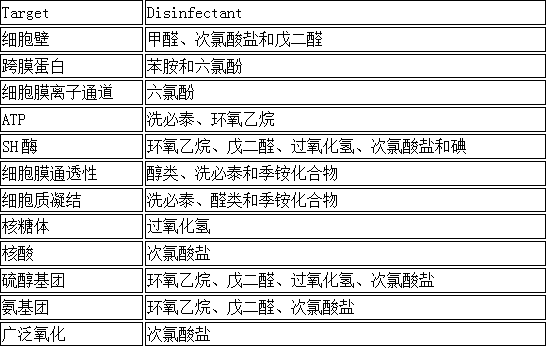今天我們就來好好了解一下車間和實驗室里隨處可見的消毒劑。
消毒劑選型
使用消毒劑并不是簡單選擇廣譜消毒劑或高效滅菌劑就能簡單解決的。
不同環(huán)境中常見的菌種有很大差異,不同區(qū)域選擇合適的消毒劑,是風險評估需要完成的目標。
在制定消毒劑輪換周期的時候,也需要考慮消毒劑之間的作用機理差異,以避免耐受菌的出現(xiàn)。 在無菌產(chǎn)品生產(chǎn)環(huán)境,消毒劑更應(yīng)進行過無菌處理,而且鼓勵殺孢子劑和消毒劑交替使用。
常見消毒劑的種類


實際應(yīng)用的過程中,消毒劑的選型需要考慮的,遠不止機理。消毒劑的味道、使用后的殘留情況、與材質(zhì)的相容性都需要綜合考慮。因此,消毒劑選型更是一項綜合性決策,別人成熟的方案,也只能參考不能照搬。
消毒劑的使用方式取決于需消毒設(shè)備設(shè)施的情況,選擇合適的消毒劑使用方法。常見的方式包括:噴灑、拖擦、擦拭、霧化與汽化。各種方式各有優(yōu)缺點,應(yīng)按需選用。
要確定消毒劑效果好不好,制藥行業(yè)必須在實際應(yīng)用前進行驗證,證明是否適合使用。常見的方式是硬面測試法和定量懸浮法。
To demonstrate the efficacy of a disinfectant within a pharmaceutical manufacturing environment, it may be deemed necessary to conduct the following tests:
?(1) use-dilution tests (screening disinfectants for their efficacy at various concentrations and contact times against a wide range of standard test organisms and environmental isolates);
?(2) surface challenge tests (using standard test microorganisms and microorganisms that are typical environmental isolates, applying disinfectants to surfaces at the selected use concentration with a specified contact time, and determining the log reduction of the challenge microorganisms);
?(3) a statistical comparison of the frequency of isolation and numbers of microorganisms isolated prior to and after the implementation of a new disinfectant.
▲以上節(jié)選自《USP34 1072 DISINFECTANTS AND ANTISEPTICS》
?使用濃度測試:不同濃度、接觸時間對標準菌株、環(huán)境菌的殺滅能力測試;
?表面挑戰(zhàn)測試:選擇濃度后,在應(yīng)用表面使用的效果評估;
?統(tǒng)計學對比:對實際使用消毒劑前后,微生物污染水平的統(tǒng)計對比。
完整的消毒效果驗證,需要涵蓋上述三類型測試,才能符合法規(guī)要求。已在使用的消毒方案,年度也應(yīng)對消毒方案進行回顧和再驗證。
消毒是制藥生產(chǎn)GMP管理中的關(guān)鍵步驟之一,我們都應(yīng)了解清楚其中原理,充分考慮微生物污染的風險,并做充分的驗證。
參考文獻
1.USP34 1072 DISINFECTANTS AND ANTISEPTICS
2.PDA TR70 Fundamentals of Cleaning and Disinfection Programs for Aseptic Manufacturing Facilities
 招賢納士
招賢納士 了解東銳
了解東銳 了解產(chǎn)品
了解產(chǎn)品